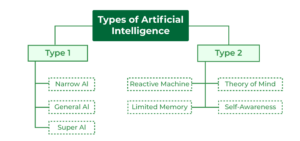Understanding AI in the Healthcare Industry
In our introduction to this series on AI in healthcare, one of our points was that “AI is not one thing.” Now we’re going to explore different aspects and provide the mission-critical information lab executives and managers need to understand to properly leverage this sensational technology; most importantly, we’ll come to an understanding on how to avoid the pitfalls and very real dangers that do exist. This is a situation of needing to “look before you leap,” and we’ll see why partnering with existing, experienced data managers with a deep understanding of the technology is crucial.
 Types of Artificial Intelligence
Types of Artificial Intelligence
Let’s start with an overview of the basic types of AI, which can be divided into three broad categories:
- Narrow AI (Weak AI)
These are AI systems that are designed and trained for a narrow, specific range of tasks, but are limited to the contexts for which they were developed. Examples: voice assistants like Siri or Alexa; self-driving cars; Netflix’s recommendation algorithms; image recognition tools such as those used in healthcare; and disease diagnosis software, where AI algorithms process a large amount of data and analyze it quickly. - General AI (Strong AI)
General AI is a theoretical form of AI used to exhibit human-like cognitive abilities across a broad range of tasks, contrary to Narrow AI. Strong AI would mean “an intelligence equal to humans; it would have a self-aware consciousness that has the ability to solve problems, learn, and plan for the future.” ( “What is strong AI?”) - Artificial Superintelligence (ASI)
ASI refers to a level of AI that surpasses human intelligence in all aspects, and could lead to great advancements in science, technology and countless other applications.
Of those three, General AI and Super AI are, at the moment, the fodder of science fiction. There is debate of whether these are achievable at all, but that’s a discussion for another day. We will focus on Narrow AI as it pertains to the healthcare industry.
What about Generative AI, which has been all the rage? GenAI is a groundbreaking subset of Narrow AI that can be considered the next generation of AI. It’s groundbreaking in that it is “generative” and can create something new; it’s not simply analyzing data and spitting it out in a different form; it’s learning from the data and creating something that didn’t exist before.
How real is this? It has a received a $1 billion investment from Microsoft through OpenAI (you may be familiar with the barrage of articles about its firing and rehiring of CEO Sam Altman, or about the company being sued for unauthorized use of content by everyone from comedian Sarah Silverman to the New York Times). Open AI is behind the popular GenAI tools DALL-E and ChatGPT, which exploded onto the scene in November of 2022.
Artificial Intelligence is here to stay, and while it can be an invaluable tool, it requires IT professionals familiar with healthcare data in order to perform well and as intended.
Integrating AI into the Healthcare Industry
The four most important points about AI from U.S. HealthTek’s perspective are:
- AI is a powerful revolution, but this is not an endeavor to be taken lightly; our position is that it is best handled by someone who has a deep understanding of and experience with data.
- Your strategic partner should help identify opportunities to leverage AI and to educate and guide the company through the inherent complications that arise to achieve its goals.
- This journey is going to involve constant re-education – not only in keeping up with ever-evolving technology, but because government compliance and regulations are inherently inevitable, and ever-changing.
- The goal is to identify solutions using the AI tool, and then consolidate the data and create security layers that go beyond AI.
AI’s Practicality in the Healthcare Workspace
One of the most fruitful conferences I was invited to was the AWS re:Invent symposium held in Las Vegas in November, and it’s worthy of a deep dive. There were several presentations on healthcare specifically, displaying a deep understanding of the complexity and security issues involved. They have a compliant suite of AI products that set up not only what you want AI to pull from, but what you don’t want AI to pull from. That’s an aspect that is not being talked about enough – the security and safety aspects of this technology, and the risk that AI could provide incomplete or even incorrect data without the healthcare organization realizing it.
The AWS conference outlined three different tiers or offerings. The first tier is the foundation model which serves the big companies – those who want to load terabytes of their own data, process it, use their own machine language, and get specific with what they want to do with that data.
The second tier offers tools that take advantage of underlying language models already available, that is then built out for a specific industry – like ours. That is where U.S. HealthTek is putting our energy into, with the goal of creating an even better internal organization that will respond more effectively and quicker to clients’ needs.
And then there is the third tier, which Amazon introduced at this conference, and which you may have read about – Amazon Q. Amazon Q is a new type of Generative AI tool that’s been made available to anyone. It’s a GenAI-powered assistant that can be manipulated for specific work, and with the proper handling and setup, can be tailored to a client’s business needs with great success.
 Knowing What AI Can Do Today
Knowing What AI Can Do Today
Today AI is already extremely helpful and reliable on backend systems. This includes customer service – think of AI as being a “better bot.” When administered properly, AI can take care of general customer questions, allowing staff to focus on more complex responsibilities. You can also add those mundane tasks every office is saddled with. Another example exists on a marketing level – it’s excellent in quickly identifying and understanding profitable areas for a company and can provide valuable data more quickly and more efficiently.
CFOs in our industry are going to be motivated to embrace AI for the financial savings it can offer, and looking at it to see how it can help the company be more efficient overall. And they should. But the hazards that exist, in addition to the potential to overspend on implementing it, are very real. At the end of the day, to fully, effectively leverage AI tools in the most economic and secure way, we need to never forget that this is all about data – so experienced data managers need to be its shepherd.
We’ll be talking more about AI in the coming months – to stay in the loop, be sure to subscribe to our mailing list to be notified whenever a new article is posted.


